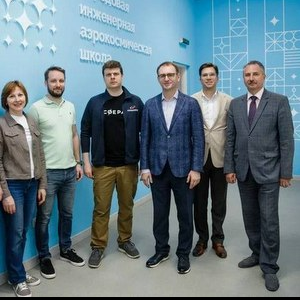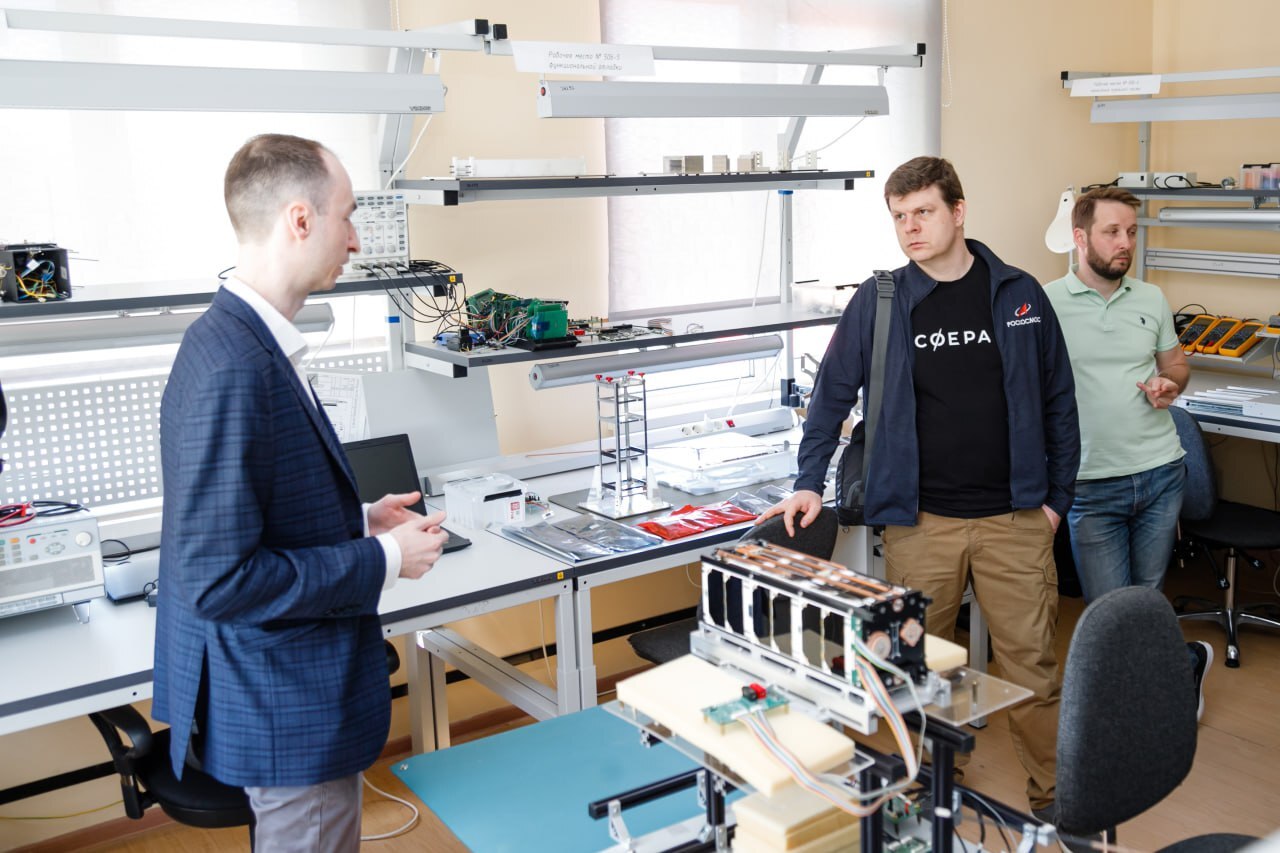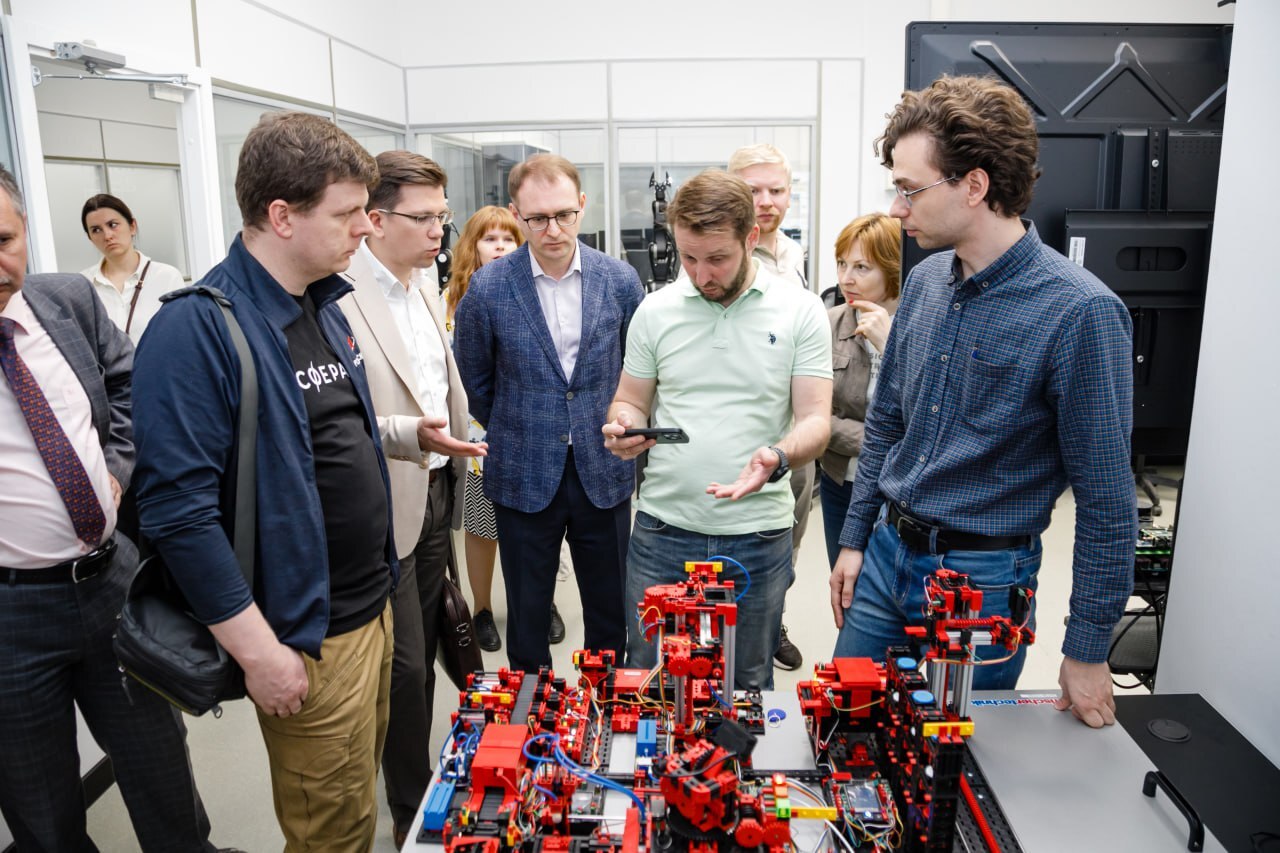The delegation of the State Corporation “Roscosmos,” headed by Aleksander Bloshenko, Deputy General Director for Space Complexes and Science, paid a working visit to Samara University. Together with Oksana Wolf and Igor Pshenichnikov, Deputy Directors of the Department of Advanced Programs and the project “Sphere,” and Aleksander Mitkin, Deputy General Designer for Electrical Systems at JSC “NPO Lavochkin,” he examined the University’s research and production laboratories and educational spaces.
Small spacecrafts — to series production
The delegation got acquainted with the activities of the cyber-physical factory for production of small spacecrafts (SSC). It is situated in the building of the “RSC “Progress” located on the University campus. As part of the development program of the University’s Advanced Aerospace Engineering School (AAES), the experimental section for robotic assembly of small spacecrafts, which is equipped with automated component storage systems, machine vision systems, collaborative robots, and robotic transport systems, has been created at this production and test site. After visiting the cyber-physical factory, Aleksander Bloshenko noted that the University’s experience in organizing such an experimental section of the SSC robotic assembly is very curious, and the State Corporation “Roscosmos” is interested in scaling it.
Aleksander Bloshenko got acquainted with operation of the cyber-physical factory for production of small-sized gas-turbine engines (SSGTE), as well. This experimental site was also established as part of the AAES development, for testing design and organizational-technical solutions, experimental research on creating SSGTE using domestic systems, additive technologies, robots and high-performance machining at processing centres.
Aleksander Bloshenko and Aleksander Mitkin got interested in advanced methods of “growing” parts for SSGTE of various types and for the needs of distributed energy by using 3D printing, as well as capacities for manufacturing tooling and other parts for Nano Class satellites at the factory.
Nano Class devices
At the Inter-University Department of Space Research, the delegation members were told about the current nanosatellite testing centre and laboratories that make it possible to solve the extensive range of tasks for testing and improving nanosatellite systems of the CubeSat 1U-3U Standard and their subsystems. The guests were shown workshops where students perform laboratory work on educational models of nanosatellites.
The guests also learned that scientists of the Department developed special educational programs in compliance with the standards of the UN Committee on the Use of Outer Space, under one of which the group of engineers from the Myanmar Space Centre successfully trained in 2023. Scientists of the Department plan to launch into orbit the “SamSat-Orion” Nanosatellite designed to monitor the ionosphere state.
Generations of outer-space “AISTs”
Aleksander Bloshenko also paid great attention to capacities and results of operation of the University’s Outer-Space Data Reception and Processing Centre. It receives and processes signals and satellite images from SSCs, in particular, from the first-generation SSC “AIST,” which has already been operating in orbit for 11 years. This device was created by specialists of the RSC “Progress” and the University’s scientists, with the students’ active participation. In total, since 2013, three devices of the series “AIST” have been launched and successfully operated into orbit, including two SSC “AIST” and SSC “AIST 2D.”
In 2024, scientists began testing a new SSC — “AIST ST.” It is a 12-unit nanosatellite equipped with the radar and designed for radar monitoring of the Earth’s surface. The SSC is able to “see” through dense clouds, by using centimeter radio waves. It is being created by the University, together with specialists of the company “Special Technology Centre” from St. Petersburg. The delegation members were particularly interested in the University’s capacities for the Earth remote sensing, using hyperspectral equipment, and receiving outer-space data. According to Aleksander Bloshenko, the University has a good export potential here.
Graduation of new-formation specialists
The working visit ended with attending special educational spaces of the University’s Advanced Aerospace Engineering School. New-formation engineers, who have passed intra-university selection in the AAES, are trained here. Graduation of the first group of students is scheduled in 2024.
The members of the State Corporation examined special educational spaces where students learn robotics and mechatronics, practice additive technologies, study the Industrial Internet of Things, as well as intricacies of engineering by using VR technologies.
Comments:
Aleksander Bloshenko, Deputy General Director for Outer-Space Complexes and Science, State Corporation “Roscosmos”:
“We planned to see what kind of groundwork and developments Samara University has in the field of automated production for manufacturing small spacecrafts. We saw the experimental sector where the robotic assembly of small spacecrafts was organized in a very good time, as well as we looked at the spaces where nanosatellites are assembled. This visit resulted in our exceptionally positive impression of what we saw.
Moreover, as part of development of relations with the BRICS countries, we see a great demand for educational tracks from the countries that want to boost space activities. And they are interested not only in buying our space technology, they plan to study our SSC production technologies, and our BRICS partners begin the conversation with the issue of nanosatellites. Together with JSC “Glavkosmos” and Samara University, we are going to form the pool of specialized educational programs, for exporting them abroad.
We also agreed with the University’s Administration to form the personnel request for employment of the University’s graduates to “NPO Lavochkin,” RSC “Progress,” RSC “Energia,” for the purpose of clarifying which specialists in ballistics, aerodynamics, and IT they need right now, and which ones will be needed, relatively speaking, tomorrow.
Vladimir Bogatyrev, Rector of Samara University:
“The State Corporation “Roscosmos” is the University’s key industrial partner not only in the Advanced Aerospace Engineering School, but also in a number of projects. We are interested in expanding the collaboration in the framework of scientific research and development, in development of commercial outer space, and see our mission not only in training highly qualified personnel for the industry, but also in creating new-generation aerospace engineering.
The University plans to develop technologies for the robotic assembly of small spacecrafts on the basis of the cyber-physical factory, and transfer these technologies to our industrial partners.
Photo: Elena Lukyanova
 RU
RU  EN
EN  CN
CN  ES
ES 




